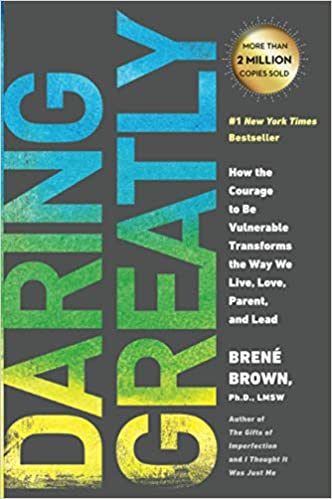This really powerful Niccolò Machiavelli quote says, “Develop the strength to do bold things, not the strength to suffer.”
What this quote tells us that being truly courageous and brave is being bold. It’s about being our authentic self. And it’s not about pretending that everything is okay. People often associate courage with assertiveness, and they also think of courage as meaning “staying strong” and not ever showing feelings.
That’s simply untrue.
Showing vulnerability isn’t something cowardly. It’s certainly nothing to be ashamed of. And when you have enough courage to show and share vulnerability, that gives the message to other people that it’s alright for them to be vulnerable. You’re assertive by telling people when you feel anxious, vulnerable, or unsure.
So are you vulnerable enough to be brave?
Today, we will discuss the relationship between vulnerability and bravery and how the two words are not an antonym, as most people believe.

Daring Greatly
by Brene Brown
⏱ 17 minutes reading time
🎧 Audio version available
One of the loudest voices in the crusade to take the stigma of vulnerability and show its relation to bravery is Brené Brown. Brené Brown is an American professor, lecturer, author, and podcast host.
She holds the Huffington Foundation’s Brené Brown Endowed Chair at the University of Houston’s Graduate College of Social Work and is a visiting professor in management at McCombs School of Business at the University of Texas at Austin.
Now, imagine that almost the entirety of what Brown built her career on is the power of vulnerability. For over a decade, she’s been studying vulnerability, courage, authenticity, and shame.
Brown believes in the original definition of courage. The original definition of the word because when it first came into the English language, it came from the Latin word “cor,” which means heart.
Brown believes that courage is telling the story of who you are with your whole heart. She believes in embracing vulnerability, and that vulnerability is what makes a person beautiful.
She believes that vulnerability isn’t being comfortable, nor is it particularly excruciating either. It’s just necessary. It’s the willingness to say “I love you” first to a partner. It’s the willingness to do something when there are no guarantees.
It’s the willingness to breathe through waiting for difficult results from the doctor. And it’s the willingness to invest in a relationship that may or may not work out eventually.
Those examples don’t sound a lot like the popular definition of vulnerability, which is thought to be the core of fear, shame, and the struggle for worthiness.
These examples sound a lot like bravery.
And that’s the true definition of vulnerability. It’s the “birthplace of joy, of creativity, of belonging, of love.”So the act of allowing yourself to be vulnerable and sharing that vulnerability is one of the bravest things you can do.
Vulnerability is about self-acceptance. You’re saying that this is who you are, and people have to accept you as you are. At this moment, you may not be comfortable, but you’re human, and you’re expressing yourself.
Are you vulnerable enough to comfortably have difficult conversations? Are you brave enough?
People think they’re committing acts of kindness by avoiding difficult conversations when they’re doing the opposite. They’re unkind by not being clear. This is them projecting and making their discomfort a priority.
Being brave is exclusively limited to this quote-unquote “kindness” and fable that you’re polite.
One of the biggest challenges related to this is that leaders lack knowledge or skills and the courage to be vulnerable.
That facade is harmful. You’re not bulletproof, and it’s a disservice to tell your employees that they have to be unaffected and unmovable all the time. We’re not made to be constantly rolling with the punches, not to show that we’re hurt when we’re hurt.
A leader admitting their mistakes and showing that vulnerability is important to the work environment.
When you accept that you don’t know all the answers, you may need others’ support, which requires more courage than handling things on your own.
The world often teaches that to be successful and to be perceived as a force to be reckoned with in it, we need to have all the answers and that we need to always be right.
It’s crucial to remember that we are all human beings and acknowledgment that we are human beings, individuals with our fears, anxieties, feelings, and experiences.
People, especially in the workplace, avoid sharing personal stories as if it’s to illustrate how powerful and in control they are. They don’t know that it’s one of the most powerful tools you can wield. And it comes down to people not wanting to be vulnerable and risking the response of the people around them.
You’ll find that people are more drawn to the powerful ability to showcase vulnerability. Just because of how rare it is to see influential people sharing stuff from their personal lives, insecurities, or something they struggled with. It just resonates better and draws people to listen closely to your message.
When you tell a personal story in a casual setting or even when you’re presenting something, it’s important to have an open conversation. It’s important to ask questions and to carefully listen to the answer to show people that you’re vulnerable enough to hear and understand their troubles.
Now, here’s how to tell a transformational story about yourself and show your vulnerability: there’s a three-step process.
The first is that you have to establish yourself as someone approachable and likable so that people can relate more to you and root for you.
Next, you can explain the struggle you encountered or the problems. Tell them how you struggled, how you persevered, and whether you overcame this issue or not, and what you learned from it.
We have the misguided sense that a good story has to follow a certain plot in which the main hero always knew right from wrong, but it’s okay to show all the other bits.
But it’s not easy to paint yourself from the unflattering angle of showing how you were wrong at first, how you were knocked down or fooled. When people tell their stories, they cut off this awkward part in fear of the reception of their stories and how it may affect their reputation.
But did you know that it’s the low points that make the story so powerful?
The best parts that you victoriously emerge are only made so glorious by telling the low points.It’s the same way movies tell you that they’re based on a true story that connects so much more with people.
They’re so much more powerful than fiction when you learn about all the lows and highs straight from the people who experience them.
By being vulnerable enough to tell your story the way you did, you’re also making your listeners take a closer look at their own mistakes.
So the next time you’re tempted to skip over or cut out the part that makes you comfortable– or the part you’re afraid will make people uncomfortable because it doesn’t shine the best light on you, think again about why you’re doing this.
Do you think people will connect with you more because you seemed invulnerable? Is your message more powerful this way?
Or are you brave enough to use this to your advantage? Are you confident enough in your vulnerability to trust it to make your story better?
Vulnerability isn’t a word people should shirk from. It’s just a state, an emotion. It’s not a weakness. Being vulnerable is this: it’s a state where you expose and open yourself up to judgment. It’s showing that you need help from others. And there’s absolutely nothing wrong with that.
If someone does judge you, that’s on them, not you. They did it because they lack empathy. But a lot of people judge because they are terrified of being judged. It’s an endless, vicious cycle.
When we are vulnerable, yes, there is a certain risk. We risk facing disappointment. We risk not finding the support we wanted from our loved ones or our friends.
So every time you’re vulnerable, you’re taking a risk in sharing that dark moment in your life. And taking a risk is the bravest thing you can do. It only takes a brave person to show that side of themselves, to show others that their lives aren’t perfect.
Our trials in life are nothing to be ashamed of. You only find out who your true friends are when you show them your vulnerabilities. But if you never dare to show them, you’ll never know.
Take the words of Brené Brown, who said that “vulnerability is not weakness: it’s our greatest measure of courage. Vulnerability is not winning or losing: it’s having the courage to show up and be seen when we have no control over the outcome.”
What Is Snapreads?

With the Snapreads app, you get the key insights from the best nonfiction books in minutes, not hours or days. Our experts transform these books into quick, memorable, easy-to-understand insights you can read when you have the time or listen to them on the go.


